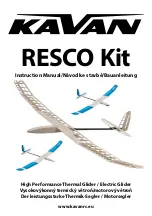
6
Methods for rapid descent
Try to avoid these maneuvers whenever possible. Carefully assess the weather conditions before
take-off. If there is a probability of deterioration of weather conditions, choose a landing pad and
approaches to it in advance.
"Big ears"
To accomplish this maneuver, take the most external lines of A-risers (which go to the outer
edges of the wing) and pull them until the wing tips are folded.
To increase the horizontal and vertical speeds in this mode, you can activate a accelerator, but
only AFTER folding the ears.
During this maneuver, it is strictly recommended not to make deep spirals, as this negatively
affects the strength and geometry of the line system.
To exit, simply release the held lines and fill the wing yourself. It is possible to accelerate the
opening with the help of a not very intensive pumping of the wing by the brakes.
Deep spiral
Before performing a deep spiral, make sure that there is sufficient margin of elevation above the
ground. To enter the spiral, shift the weight in the harness to one side and gently tighten the
brake on the same side until the wing starts to rotate.
When the wing increases the bank angle and accelerates to a certain reduction, hold the brake in
this position. The rate of descent can be controlled by weight shifting in the harness and small
action of the external (from the rotation) brake.
To exit from a deep spiral simply smoothly release the internal (working) brake and the
paraglider will start its own exit. For a smoother exit, it may sometimes be necessary to apply a
slight brake to the wing to compensate for small wing movements in the pitch before final exit
into a normal straight flight. FireStarter in normal flight conditions has no tendency to remain in
the spiral on its own.
It should always to remember that the greater the rate of descent in the spiral dive, the more time
it can take to exit into a normal flight.
Never attempt an abrupt escape from a deep spiral - this can lead to very dangerous abnormal
flight situations.
A WARNING. Prolonged overloads during a deep spiral dive can lead to deterioration of the
pilot's well-being and even loss of consciousness. Constantly monitor your condition in this
maneuver, and at the first signs of deterioration of well-being, begin to exit of this maneuver. It
is strongly recommended not to perform deep spirals for a long time at a speed of more than 11
m / s. Pilot should training to do spiral dive in a safe conditions - with a large margin of height
above the water and under the supervision of an experienced instructor.
Too frequent using of deep spirals with high rates of descent can cause premature violation of
the geometry of the line system and the canopy of the wing with the subsequent deterioration of
flight characteristics up to dangerous ones.
B-stall
To perform this maneuver, symmetrically tighten the B-risers before mechanically restricting of
risers achieved.
The canopy of the paraglider will be deformed along the span, lose the horizontal speed and
increase the speed of descent. The decrease can reach values of 7-8 m / s.
Never do not release the risers until the moment when the wing does not stabilize vertically
above the pilot! In the opposite case, a wing can be dive forward below the pilot with subsequent
dangerous flight situations!
To exit the B-stall quickly and symmetrically release the straps of the B-riser. The wing will
come out by itself to a normal flight with a slight pitch movement.
We at S.E.A. Paragliders strongly recommend to avoid using B-stall due to liteweight design of
the FireStarter.
Summary of Contents for FireStarter
Page 8: ...8 4 General view of the paraglider ...
Page 10: ...10 6 Lines diagram ...































